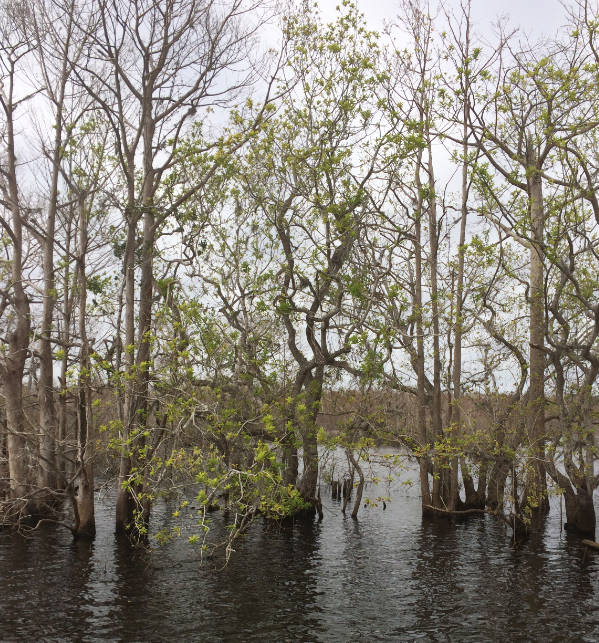Tupelo honey season should be just around the corner. However, this year’s bloom is more difficult than ever to predict, thanks to Hurricane Michael.
You’ve probably noticed strange things, like early bloom, happening to plants in your very own landscape. This kind of response is typical when a plant is stressed by storm events. Tupelo trees are not immune to this phenomenon. High winds, flooding and plant structure damage all play a role in disrupting plant hormones which trigger responses like early bloom. Even the trees that survived Hurricane Michael have been truly affected.

Figure 1. Tupelo trees in different foliage stages – February 2019. Credit: Ray Bodrey, UF/IFAS Extension Gulf County
The Panhandle is known for its honey production. Gallberry, wildflower and other pollens make quality honey but for most, tupelo is by far the first choice in flavor and as such it demands the highest price. For decades, tupelo honey has been synonymous with Gulf county, and the Apalachicola River Valley. The pollen from the tupelo gum tree, Nyssa ogeche, that resides in this area, produces some of the finest honey that can be found. The common name “tupelo” is derived from language of the Muscogee Nation, also known as the Creek Indian Nation. The meaning of the word is “swamp tree”, as this tree flourishes in areas of wet soils with seasonal flooding.
The Dead Lakes region of Gulf County is home to one of the largest stands of tupelo in the world. Recently, representatives of UF/IFAS Extension Gulf County, Florida Forest Service, and Off the Map Expeditions surveyed the Dead Lakes in an effort to formulate a tupelo damage assessment. The results were positive regarding tree density in this area. In other words, the population of tupelo seems healthy, with minimal tree damage.
However, the tupelo bloom in 2019 is a major concern. Tupelo trees traditionally bloom from mid-April to mid-May. Many of the trees that were surveyed have already bloomed (as early as December) and some are approaching the blooming stage in a matter of weeks. There are also reports, that recent blooms where not fully developed. Some trees are also well into leaf production while others have passed that point. This leads to real questions on the amount of viable blooms in the coming months, as the trees seem to be in a state of confusion. The effects of Hurricane Michael continue to reveal themselves as local beekeepers are faced with the likelihood that the blooms needed for the production of their most valuable honey may be in short supply this year.
For more information please contact your local county extension agent. For more information on Gulf County Tupelo Honey, please visit:
http://www.tupelohoneyfestival.com/
https://www.visitgulf.com/tupelo-honey
Background information contained in this article can be found in the UF/IFAS EDIS publication “Health Benefits and Medicinal Value of Honey” by Sara Marshall, Liwei Gu and Keith R. Schneider.